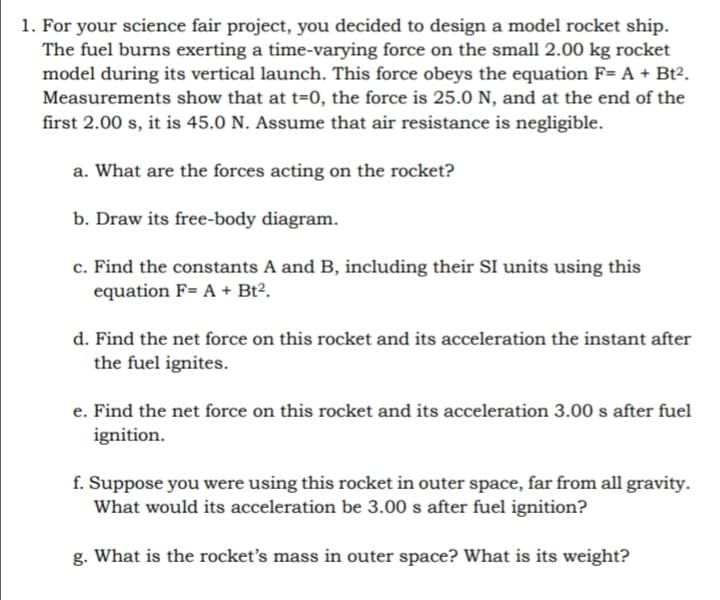1. For your science fair project, you decided to design a model rocket ship. The fuel burns exerting a time-varying force on the small 2.00 kg rocket model during its vertical launch. This force obeys the equation F= A + Bt². Measurements show that at t=0, the force is 25.0 N, and at the end of the first 2.00 s, it is 45.0 N. Assume that air resistance is negligible. a. What are the forces acting on the rocket? b. Draw its free-body diagram.
1. For your science fair project, you decided to design a model rocket ship. The fuel burns exerting a time-varying force on the small 2.00 kg rocket model during its vertical launch. This force obeys the equation F= A + Bt². Measurements show that at t=0, the force is 25.0 N, and at the end of the first 2.00 s, it is 45.0 N. Assume that air resistance is negligible. a. What are the forces acting on the rocket? b. Draw its free-body diagram.
Principles of Heat Transfer (Activate Learning with these NEW titles from Engineering!)
8th Edition
ISBN:9781305387102
Author:Kreith, Frank; Manglik, Raj M.
Publisher:Kreith, Frank; Manglik, Raj M.
Chapter1: Basic Modes Of Heat Transfer
Section: Chapter Questions
Problem 1.5P: To determine the thermal conductivity of a structural material, a large 15-cm-thick slab of the...
Related questions
Question

Transcribed Image Text:1. For your science fair project, you decided to design a model rocket ship.
The fuel burns exerting a time-varying force on the small 2.00 kg rocket
model during its vertical launch. This force obeys the equation F= A + Bt2.
Measurements show that at t=0, the force is 25.0 N, and at the end of the
first 2.00 s, it is 45.0 N. Assume that air resistance is negligible.
a. What are the forces acting on the rocket?
b. Draw its free-body diagram.
c. Find the constants A and B, including their SI units using this
equation F= A + Bt².
d. Find the net force on this rocket and its acceleration the instant after
the fuel ignites.
e. Find the net force on this rocket and its acceleration 3.00 s after fuel
ignition.
f. Suppose you were using this rocket in outer space, far from all gravity.
What would its acceleration be 3.00 s after fuel ignition?
g. What is the rocket's mass in outer space? What is its weight?
Expert Solution
This question has been solved!
Explore an expertly crafted, step-by-step solution for a thorough understanding of key concepts.
This is a popular solution!
Trending now
This is a popular solution!
Step by step
Solved in 2 steps with 1 images

Knowledge Booster
Learn more about
Need a deep-dive on the concept behind this application? Look no further. Learn more about this topic, mechanical-engineering and related others by exploring similar questions and additional content below.Recommended textbooks for you

Principles of Heat Transfer (Activate Learning wi…
Mechanical Engineering
ISBN:
9781305387102
Author:
Kreith, Frank; Manglik, Raj M.
Publisher:
Cengage Learning

Principles of Heat Transfer (Activate Learning wi…
Mechanical Engineering
ISBN:
9781305387102
Author:
Kreith, Frank; Manglik, Raj M.
Publisher:
Cengage Learning